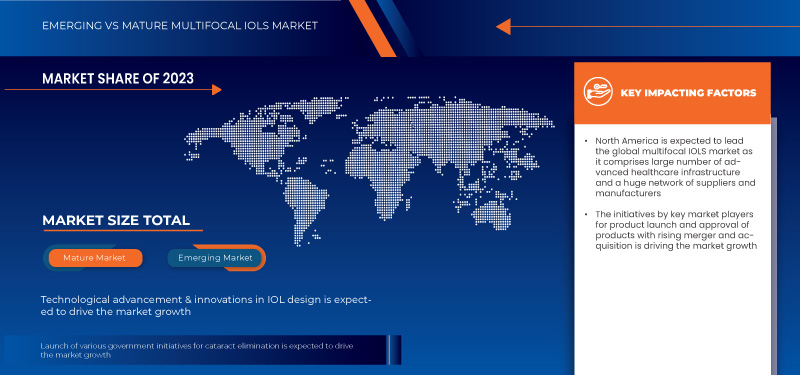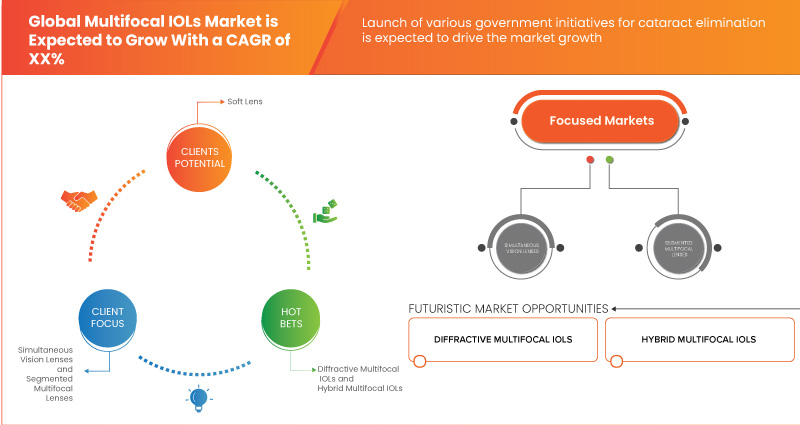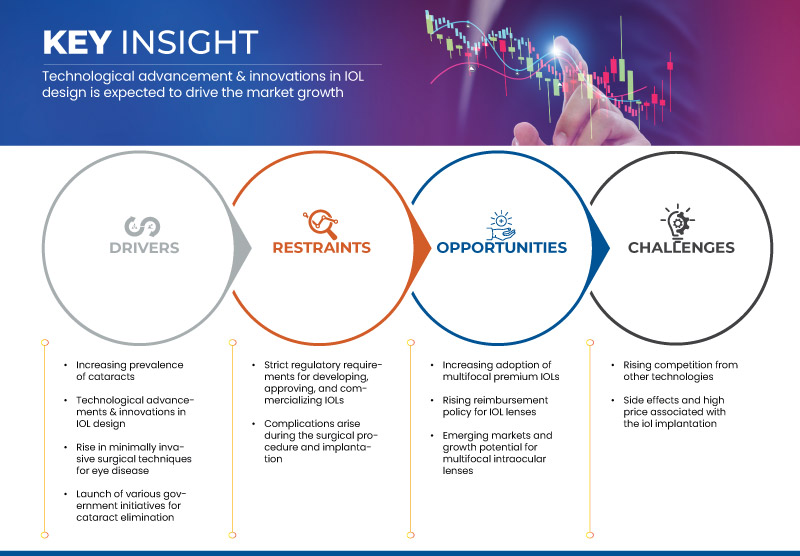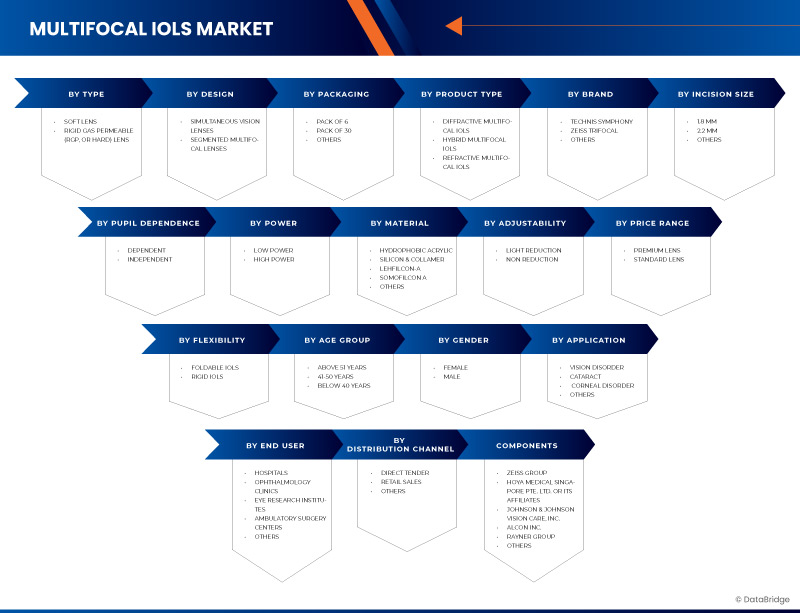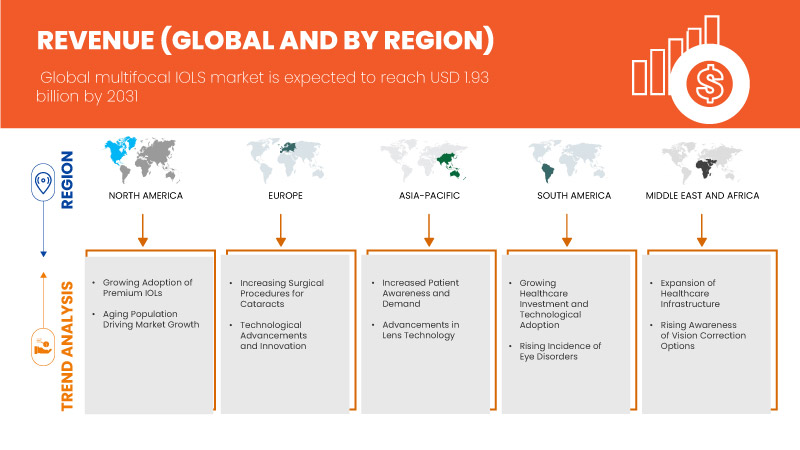Global Multifocal Iols Market
Taille du marché en milliards USD
TCAC :
% 
 USD
1.25 Billion
USD
2.05 Billion
2024
2032
USD
1.25 Billion
USD
2.05 Billion
2024
2032
| 2025 –2032 | |
| USD 1.25 Billion | |
| USD 2.05 Billion | |
|
|
|
Global Multifocal IOLs Market Segmentation, By Type (Soft Lens and Rigid Gas Permeable (RGP, or Hard) Lens), Design (Simultaneous Vision Lenses and Segmented Multifocal Lenses), Packaging (Pack of 6, Pack of 30, and Others), ProductType (Diffractive Multifocal IOLs, Hybrid Multifocal IOLs and Refractive Multifocal IOLs), Brand (Technis Symphony, Zeiss Trifocal, and Others), Incision Size (1.8 MM, 2.2 MM, and Others), Pupil Dependence (Dependent and Independent), Power (Low Power and High Power), Material (Hydrophobic Acrylic, Silicon & Collamer, Lehfilcon-A, Somofilcon A and Others), Adjustability (Light Reduction and Non Reduction), PriceRange (Premium Lens and Standard Lens), Flexibility (Foldable IOLs and Rigid IOLs), AgeGroup (Above 51 Years, 41-50 Years and Below 40 Years), Gender (Female and Male), Application (Vision Disorder, Cataract, Corneal Disorder, and Others), End User (Hospitals, Ophthalmology Clinics, Eye Research Institutes, Ambulatory Surgery Centers and Others), Distribution Channel (Direct Tender, Retail Sales and Others) - Industry Trends and Forecast to 2031.
Multifocal IOL Market Analysis and Insights
Increasing prevalence of cataracts is expected to drive rising prevalence of heat-related illnesses in the global multifocal IOLs market.
Data Bridge Market Research analyzes that the global multifocal IOLs market is expected to reach USD 1.93 billion by 2031 from USD 1.22 billion in 2023, growing with a CAGR of 6.4% in the forecast period of 2024 to 2031.
|
Report Metric |
Details |
|
Forecast Period |
2024 to 2031 |
|
Base Year |
2023 |
|
Historic Years |
2022 (Customizable to 2016–2021) |
|
Quantitative Units |
Revenue in USD Billion |
|
Segments Covered |
Type (Soft Lens and Rigid Gas Permeable (RGP, or Hard) Lens), Design (Simultaneous Vision Lenses and Segmented Multifocal Lenses), Packaging (Pack of 6, Pack of 30, and Others), Product Type (Diffractive Multifocal IOLs, Hybrid Multifocal IOLs and Refractive Multifocal IOLs), Brand (Technis Symphony, Zeiss Trifocal, and Others), Incision Size (1.8 MM, 2.2 MM, and Others), Pupil Dependence (Dependent and Independent), Power (Low Power and High Power), Material (Hydrophobic Acrylic, Silicon & Collamer, Lehfilcon-A, Somofilcon A and Others), Adjustability (Light Reduction and Non Reduction), Price Range (Premium Lens and Standard Lens), Flexibility (Foldable IOLs and Rigid IOLs), Age Group (Above 51 Years, 41-50 Years and Below 40 Years), Gender (Female and Male), Application (Vision Disorder, Cataract, Corneal Disorder, and Others), End User (Hospitals, Ophthalmology Clinics, Eye Research Institutes, Ambulatory Surgery Centers and Others), Distribution Channel (Direct Tender, Retail Sales and Others) |
|
Countries Covered |
China, India, Australia, South Korea, Japan, Indonesia, Malaysia, Singapore, Thailand, Philippines, Vietnam, Rest of Asia-Pacific, Brazil, Argentina, Peru, Rest of South America, France, Germany, U.K., Italy, Spain, Russia, Switzerland, Netherlands, Hungary, Lithuania, Turkey, Ireland, Austria, Poland, Norway, Rest of Europe, U.S., Canada, Mexico, South Africa, U.A.E., Egypt, Kuwait, Israel, and Rest of Middle East and Africa
|
|
Market Players Covered |
Johnson & Johnson, Inc., Hoya Medical Singapore Pte. Ltd. or Its Affiliates, Zeiss Group, Alcon Inc., Rayner Group, Lenstec, Inc., Aurolab, Excellent Hi-Care Pvt Ltd, Sav-Iol SA, Vsy Biotechnology Gmbh, Hanita Lenses Ltd, Care Group, Iolart, Omni Lens Pvt. Ltd., Ophtec BV and, among others. |
Market Definition
The global multifocal (IOLs) market refers to the segment of the ophthalmic industry that focuses on the development, production, and distribution of advanced intraocular lenses designed to correct presbyopia and other vision impairments in patients undergoing cataract surgery or lens replacement procedures. Multifocal IOLs are engineered to provide clear vision at multiple distances—near, intermediate, and far—reducing or eliminating the need for glasses or contact lenses after surgery. This market is driven by an aging global population, increasing prevalence of cataracts, advancements in lens technology, rising awareness of premium IOL options, and growing demand for improved quality of life among patients seeking better visual outcomes post-surgery.
Global Multifocal (IOLs) Market Dynamics
This section deals with understanding the market drivers, opportunities, restraints, and challenges. All of this is discussed in detail below:
Driver
- Increasing Prevalence of Cataracts
The increasing prevalence of cataracts, particularly among the aging population, serves as a significant driver for the global multifocal intraocular lenses (IOLs) market. As cataracts remain the leading cause of blindness and visual impairment worldwide, the demand for effective and long-lasting solutions has surged. Multifocal IOLs offer a compelling alternative to traditional lenses by enabling patients to focus at multiple distances without the need for additional corrective eyewear. This capability is particularly appealing to a growing demographic of older adults who wish to maintain an active lifestyle post-cataract surgery. With the global population aging and the incidence of cataracts rising in tandem, healthcare providers and patients alike are increasingly turning to advanced multifocal IOLs to restore clear vision across different focal points. Furthermore, technological advancements in lens design, such as improved light distribution and reduced halos and glare, have enhanced patient outcomes, driving greater adoption. The convergence of these factors, coupled with an increasing awareness of the benefits of multifocal IOLs, is propelling market growth as more individuals opt for these innovative lenses to improve their quality of life following cataract surgery.
For instance,
- In May 2023, according to the article published in NCBI, this study calculated the age-standardized prevalence rate (ASR) and annual percentage change (EAPC) to show the trends of cataracts in China and different regions. The result indicates that the ASR increased from 867.09 in 1990 to 991.56 in 2019 per 100,000, with an EAPC of 0.88 in China. The projective model suggests that the ASR for cataracts will rise to 1101.35×106 for males and 1616.63×106 for females by 2030. The trends from 1990 to 2030 indicated that the burden of cataracts remains high in China. This data shows that the number of cataracts is more and will increase in the future, which will divert the growth of the market
Restraint
- Strict Regulatory Requirements for Developing, Approving, and Commercializing IOLS
Stringent regulatory challenges present a significant and multifaceted restraint in the global multifocal intraocular lenses (IOLs) market, as the pathway to developing, obtaining approval, and commercializing these advanced medical devices is fraught with complex, time-consuming, and costly hurdles that vary significantly across different regions. Regulatory bodies such as the U.S. Food and Drug Administration (FDA), the European Medicines Agency (EMA), and their counterparts in other parts of the world impose stringent requirements for the clinical evaluation of multifocal IOLs, necessitating robust and comprehensive safety and efficacy data to ensure that these devices meet the highest standards of patient care. This process often involves multiple phases of clinical trials, extensive pre-market approval submissions, and rigorous post-market surveillance, each step of which demands significant financial investment, human resources, and time. Companies are required to meticulously document every aspect of their product development, from the initial design and manufacturing processes to the long-term performance of the IOLs in diverse patient populations. This extensive documentation must not only prove the device's safety and effectiveness but also demonstrate compliance with the ever-evolving regulatory guidelines, which can differ significantly between regions, further complicating the approval process. The variability in regulatory standards and the necessity to obtain approval in multiple jurisdictions can lead to protracted delays in bringing new multifocal IOLs to market, as companies must often tailor their submissions to meet the specific requirements of each regulatory authority. These delays can stifle innovation, as the lengthy approval processes may dissuade companies from investing in the development of new technologies, knowing that the return on investment may be uncertain or significantly delayed. Also, the costs associated with navigating these regulatory landscapes, ranging from conducting large-scale clinical trials to legal and administrative expenses involved in preparing regulatory submissions, can be prohibitively high, particularly for smaller companies or new market entrants. The financial burden and uncertainty associated with meeting these stringent regulatory requirements may lead some companies to focus their efforts on markets with more predictable or lenient regulatory environments, thereby limiting the global availability of the latest multifocal IOL innovations
Opportunities
- Increasing Adoption of Multifocal Premium IOLS
The adoption of premium multifocal intraocular lenses (IOLs) is steadily increasing as patients and healthcare providers recognize their advanced capabilities in restoring vision across multiple distances. These lenses offer significant improvement over standard IOLs by reducing or even eliminating the need for glasses after cataract surgery, enhancing patients' quality of life. As awareness grows about the benefits of premium multifocal IOLs—such as clearer vision at near, intermediate, and far distances, more patients are opting for these advanced lenses, particularly those who prioritize maintaining an active lifestyle without the burden of corrective eyewear. This trend is supported by technological advancements that continues to refine the visual outcomes of these lenses, making them a more attractive choice for both patients and surgeons.
- Rising Reimbursement Policy for IOL Lenses
The rising reimbursement policies for intraocular lenses (IOLs) represents a significant factor contributing to the expansion of potential market in the future. As healthcare systems and insurance providers increasingly recognize the value of advanced IOL technologies, there has been a notable shift towards enhancing coverage for these premium lenses. The policy remarks the benefits of IOLs to patients, including improved vision quality and reduced dependence on corrective eyewear. By broadening reimbursement options, more patients can access advanced IOLs, thus driving demand in the market. Insurance companies and healthcare systems are gradually expanding their reimbursement policies to include a wider range of IOLs, such as multifocal and extended depth-of-focus lenses, which were previously considered elective or outside the scope of standard coverage.
For instance,
- In March 2023, according to an article published by the American Academy of Ophthalmology, Reimbursement policies for IOL lenses, mainly when dealing with Medicare, are clearly defined by the Centers for Medicare & Medicaid Services (CMS). CMS covers conventional IOLs implanted during cataract surgery, along with the associated facility and physician services. However, CMS does not cover presbyopia-correcting or astigmatism-correcting IOLs, nor any new technology IOLs. If a patient opts for a premium IOL not covered by Medicare, they must be informed about the out-of-pocket costs beforehand. The facility can bill the patient for the additional expenses related to premium lenses while Medicare continues to cover the cost of the conventional lens
Challenge
- Rising Competition from Other Technologies
The multifocal intraocular lens (IOL) market faces significant challenges in the coming years, primarily due to the rise of alternative vision correction technologies that are increasingly gaining attraction. Technologies such as extended depth-of-focus (EDOF) IOLs, accommodative IOLs, and trifocal IOLs are presenting viable alternatives to traditional multifocal lenses, each offering distinct advantages that caters to specific patient needs. EDOF IOLs, for instance, provides a continuous range of vision with fewer visual disturbances like halos and glare, which are common concerns with multifocal IOLs. Accommodative IOLs mimic the eye's natural focusing ability, offering a more seamless visual experience without the need for multiple focal points. Trifocal IOLs, on the other hand, offers a broader range of clear vision across all distances, further reducing the need for multifocal lenses.
Recent Developments
- In June 2024, the ZEISS Group actively promotes eye health during Cataract Awareness Month by conducting educational campaigns and free eye screenings. Their initiatives aim to raise awareness about cataract prevention and treatment, emphasizing the importance of early detection and modern surgical solutions. ZEISS's efforts include partnerships with local healthcare providers to improve access to quality eye care and support communities in managing and preventing vision impairment
- In December 2024, Pfizer Inc. announced the successful completion of its acquisition of Seagen Inc., a global biotechnology company known for discovering, developing, and commercializing transformative cancer medicines. Pfizer acquired all outstanding common stock of Seagen for USD 229 per share in cash, totalling In March 2023, The ZEISS Group design and innovate IOL and OVD Portfolio to address both patient needs and surgeon preferences. Combining innovation and precision, it offers a comprehensive selection of cataract consumables and implants, tailored for monofocal, toric, and refractive cataract surgeries
- In April 2024, Alcon, the global leader in eye care dedicated to helping people see brilliantly, showcased approximately 100 company-supported and investigator-led data presentations demonstrating its latest innovative efforts aimed at optimizing patient outcomes at the 2024 American Society of Cataract and Refractive Surgery (ASCRS) Annual Meeting, April 5-8 in Boston. In addition, the company hosts multiple peer-to-peer symposia and in-booth demonstrations of its industry-leading implantables and devices, including the Clareon intraocular lens (IOL) portfolio, cloud-based SMARTCataract surgical planner, Hydrus Microstent and more
Global multifocal IOLs market is categorized into seventeen notable segments which are based on the type, design, packaging, product type, brand, incision size, pupil dependence, power, material, adjustability, price range, flexibility, age group, gender, application, end user and distribution channel. The growth among segments helps you analyze niche pockets of growth and strategies to approach the market and determine your core application areas and the differences in your target markets.
Type
- Soft Lens
- Rigid Gas Permeable (RGP, or Hard) Lens
On the basis of type, the market is segmented into soft lens and Rigid Gas Permeable (RGP, or Hard) lens.
Design
- Simultaneous Vision Lenses
- Segmented Multifocal Lenses
On the basis of design, the market is segmented into simultaneous vision lenses and segmented multifocal lenses.
Packaging
- Pack of 6
- Pack of 30
- Others
On the basis of packaging, the market is segmented into pack of 6, pack of 30, and others.
Product Type
- Diffractive Multifocal IOLs
- Hybrid Multifocal IOLs
- Refractive Multifocal IOLs
On the basis of product type, the market is segmented into diffractive multifocal IOLs, hybrid multifocal IOLs, and refractive multifocal IOLs.
Brand
- Technis Symphony
- Zeiss Trifocal
- Others
On the basis of brand, the market is segmented into technis symphony, zeiss trifocal, and others.
Incision Size
- 8 MM
- 2 MM
- Others
On the basis of incision size, the market is segmented into 1.8 MM, 2.2 MM, and others.
Pupil Dependence
- Dependent
- Independent
On the basis of pupil dependence, the market is segmented into dependent and independent.
Power
- Low Power
- High Power
On the basis of power, the market is segmented into low power and high power.
Material
- Hydrophobic Acrylic
- Silicon & Collamer
- Lehfilcon-A
- Somofilcon A
- Others
On the basis of material, the market is segmented into hydrophobic acrylic, silicon & collamer, lehfilcon-A, somofilcon A, and others.
Adjustability
- Light Reduction
- Non Reduction
On the basis of adjustability, the market is segmented into light reduction and non reduction.
Price Range
- Premium Lens
- Standard Lens
On the basis of price range, the market is segmented into premium lens and standard lens.
Flexibility
- Foldable IOLs
- Rigid IOLs
On the basis of flexibility, the market is segmented into foldable IOLs and rigid IOLs.
Age Group
- Above 51 Years
- 41-50 Years
- Below 40 Years
On the basis of age group, the market is segmented into above 51 years, 41-50 years and, Below 40 years.
Gender
- Female
- Male
On the basis of gender, the market is segmented into female and male.
Application
- Vision Disorder
- Cataract
- Corneal Disorder
- Others
On the basis of application, the market is segmented into vision disorder, cataract, corneal disorder and others.
End User
- Hospitals
- ophthalmology Clinics
- Eye Research Institutes
- Ambulatory Surgery Centers
- Others
On the basis of end user, the market is segmented into hospitals, ophthalmology clinics, eye research institutes, ambulatory surgery centers, and others.
Distribution Channel
- Direct Tender
- Retail Sales
- Others
On the basis of distribution channel, the market is segmented into direct tender, retail sales and others.
Global Multifocal IOLs Market Regional Analysis/Insights
Global multifocal IOLs market is categorized into seventeen notable segments which are based on the type, design, packaging, product type, brand, incision size, pupil dependence, power, material, adjustability, price range, flexibility, age group, gender, application, end user, and distribution channel.
The countries covered in this market report are China, India, Australia, South Korea, Japan, Indonesia, Malaysia, Singapore, Thailand, Philippines, Vietnam, rest of Asia-Pacific, Brazil, Argentina, Peru, Rest of South America, France, Germany, U.K., Italy, Spain, Russia, Switzerland, Netherlands, Hungary, Lithuania, Turkey, Ireland, Austria, Poland, Norway, rest of Europe, U.S., Canada, Mexico, South Africa, U.A.E., Egypt, Kuwait, Israel, and rest of Middle East and Africa.
North America is expected to dominate and fastest growing region in this market due to robust initiatives taken by government. The region's increasing number of consumers in the market contribute to a strong demand for multifocal IOLs.
The country section of the report also provides individual market-impacting factors and changes in regulation in the market domestically that impact the current and future trends of the market. Data points such as new sales, replacement sales, country demographics, regulatory acts, and import-export tariffs are some of the major pointers used to forecast the market scenario for individual countries. Also, the presence and availability of global brands and their challenges faced due to large or scarce competition from local and domestic brands and the impact of sales channels are considered while providing forecast analysis of the country data.
Competitive Landscape and Global Multifocal IOLs Market Dynamics Market Share Analysis
Global multifocal IOLs market dynamics market competitive landscape provides details of competitors. Details included are company overview, company financials, revenue generated, market potential, investment in R&D, new market initiatives, production sites and facilities, company strengths and weaknesses, product launch, product approvals, product width and breadth, application dominance, and product type lifeline curve. The above data points provided are only related to the company’s focus on the market.
Some of the major market players operating in the market are Johnson & Johnson, Inc., Hoya Medical Singapore Pte. Ltd. or Its Affiliates, Zeiss Group, Alcon Inc., Rayner Group, Lenstec, Inc., Aurolab, Excellent Hi-Care Pvt Ltd, Sav-Iol SA, Vsy Biotechnology Gmbh, Hanita Lenses Ltd, Care Group, Iolart, Omni Lens Pvt. Ltd., Ophtec BV and, among others.
SKU-
Accédez en ligne au rapport sur le premier cloud mondial de veille économique
- Tableau de bord d'analyse de données interactif
- Tableau de bord d'analyse d'entreprise pour les opportunités à fort potentiel de croissance
- Accès d'analyste de recherche pour la personnalisation et les requêtes
- Analyse de la concurrence avec tableau de bord interactif
- Dernières actualités, mises à jour et analyse des tendances
- Exploitez la puissance de l'analyse comparative pour un suivi complet de la concurrence
Méthodologie de recherche
La collecte de données et l'analyse de l'année de base sont effectuées à l'aide de modules de collecte de données avec des échantillons de grande taille. L'étape consiste à obtenir des informations sur le marché ou des données connexes via diverses sources et stratégies. Elle comprend l'examen et la planification à l'avance de toutes les données acquises dans le passé. Elle englobe également l'examen des incohérences d'informations observées dans différentes sources d'informations. Les données de marché sont analysées et estimées à l'aide de modèles statistiques et cohérents de marché. De plus, l'analyse des parts de marché et l'analyse des tendances clés sont les principaux facteurs de succès du rapport de marché. Pour en savoir plus, veuillez demander un appel d'analyste ou déposer votre demande.
La méthodologie de recherche clé utilisée par l'équipe de recherche DBMR est la triangulation des données qui implique l'exploration de données, l'analyse de l'impact des variables de données sur le marché et la validation primaire (expert du secteur). Les modèles de données incluent la grille de positionnement des fournisseurs, l'analyse de la chronologie du marché, l'aperçu et le guide du marché, la grille de positionnement des entreprises, l'analyse des brevets, l'analyse des prix, l'analyse des parts de marché des entreprises, les normes de mesure, l'analyse globale par rapport à l'analyse régionale et des parts des fournisseurs. Pour en savoir plus sur la méthodologie de recherche, envoyez une demande pour parler à nos experts du secteur.
Personnalisation disponible
Data Bridge Market Research est un leader de la recherche formative avancée. Nous sommes fiers de fournir à nos clients existants et nouveaux des données et des analyses qui correspondent à leurs objectifs. Le rapport peut être personnalisé pour inclure une analyse des tendances des prix des marques cibles, une compréhension du marché pour d'autres pays (demandez la liste des pays), des données sur les résultats des essais cliniques, une revue de la littérature, une analyse du marché des produits remis à neuf et de la base de produits. L'analyse du marché des concurrents cibles peut être analysée à partir d'une analyse basée sur la technologie jusqu'à des stratégies de portefeuille de marché. Nous pouvons ajouter autant de concurrents que vous le souhaitez, dans le format et le style de données que vous recherchez. Notre équipe d'analystes peut également vous fournir des données sous forme de fichiers Excel bruts, de tableaux croisés dynamiques (Fact book) ou peut vous aider à créer des présentations à partir des ensembles de données disponibles dans le rapport.


